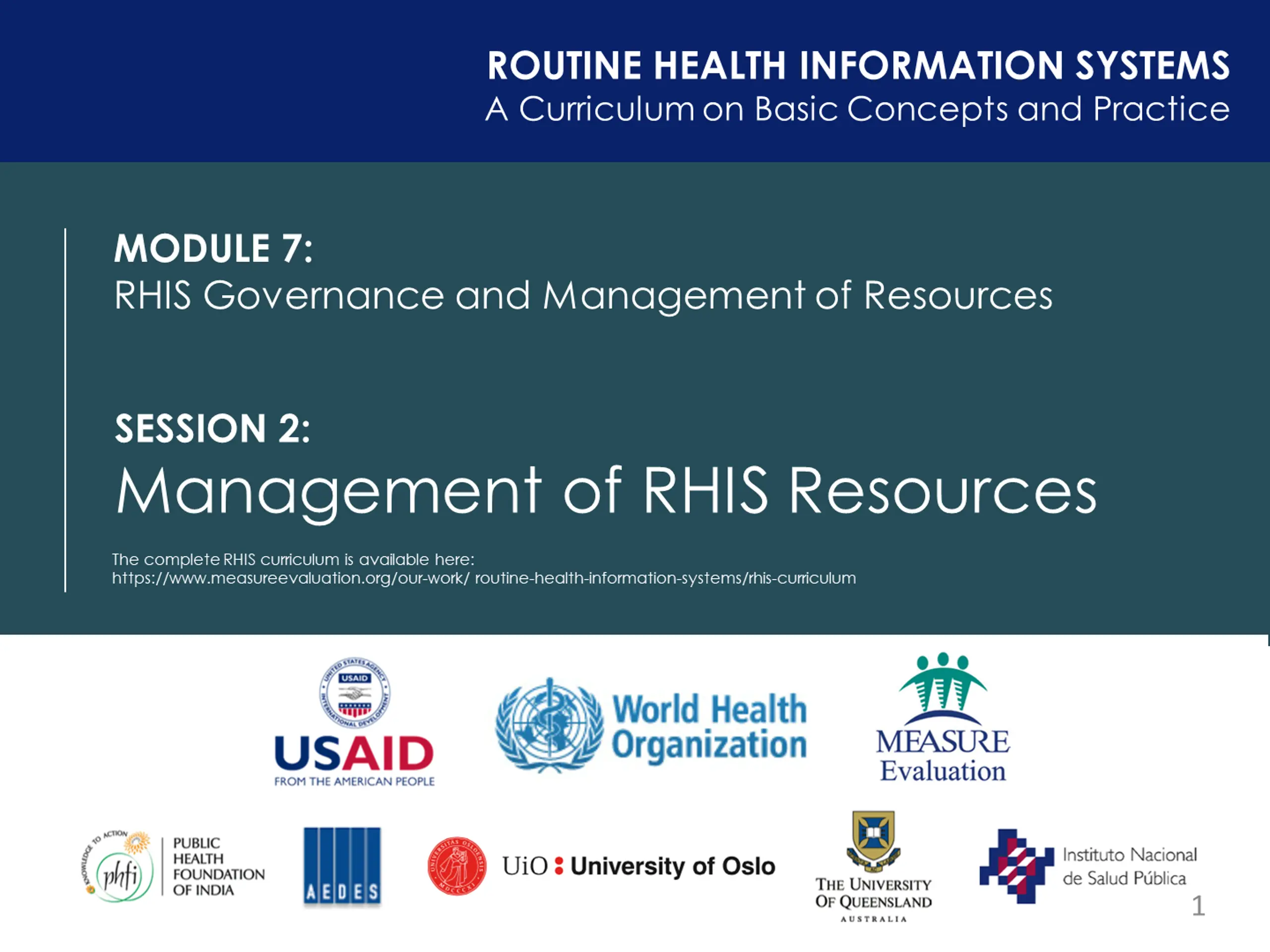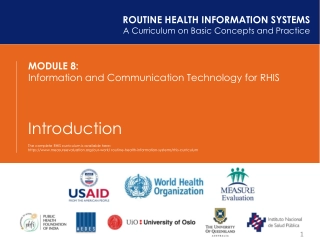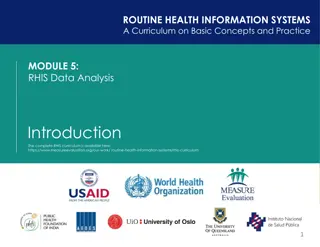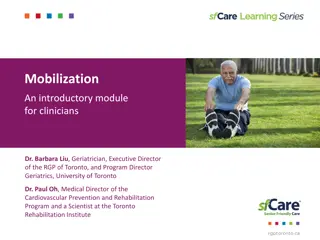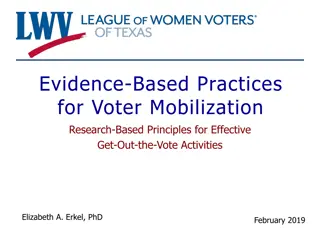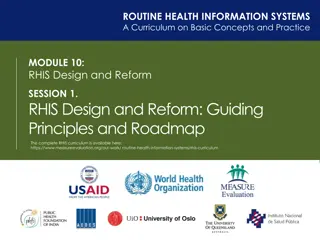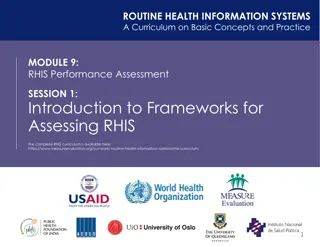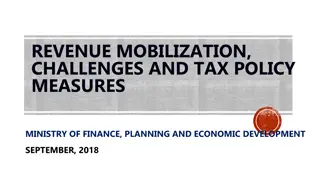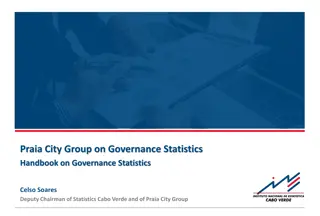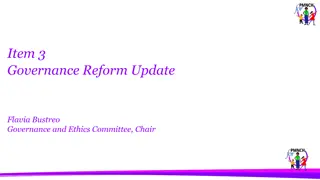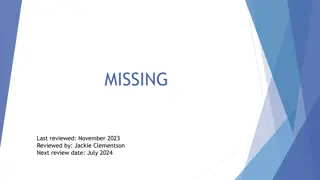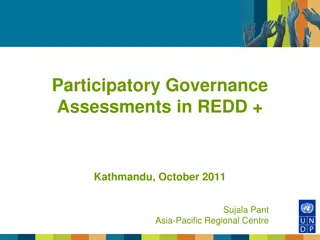Managing RHIS Resources: Governance and Mobilization
Governance and management of resources in routine health information systems (RHIS), covering topics such as human resources, financial resources, and physical resources. Participants will learn about workforce needs, training infrastructure, budgeting, procurement, and maintenance. The module also addresses the challenges associated with resource mobilization in RHIS.
Download Presentation

Please find below an Image/Link to download the presentation.
The content on the website is provided AS IS for your information and personal use only. It may not be sold, licensed, or shared on other websites without obtaining consent from the author.If you encounter any issues during the download, it is possible that the publisher has removed the file from their server.
You are allowed to download the files provided on this website for personal or commercial use, subject to the condition that they are used lawfully. All files are the property of their respective owners.
The content on the website is provided AS IS for your information and personal use only. It may not be sold, licensed, or shared on other websites without obtaining consent from the author.
E N D
Presentation Transcript
ROUTINE HEALTH INFORMATION SYSTEMS A Curriculum on Basic Concepts and Practice MODULE 7: RHIS Governance and Management of Resources SESSION 2: Management of RHIS Resources The complete RHIS curriculum is available here: https://www.measureevaluation.org/our-work/ routine-health-information-systems/rhis-curriculum 1
Learning Objectives By the end of this session, participants will: Be able to describe essential aspects of managing RHIS resources (particularly human, financial, and physical resources) Understand the importance of adhering to RHIS procedures and standards 2
Topics Covered Management of RHIS resources Human resources (staffing and workforce development) o Workforce needs/capacity assessment o Training infrastructure (database on preservice and in-service training methods, materials, policies, and resources) o Supportive supervision o Mechanisms for professional development o Adherence to procedures and standards of RHIS operations and functioning (for example, standard operating procedures) 3
Topics Covered Financial resources (financial planning and management including budgeting and accounting mechanisms) Physical resources: commodities and ICT o Needs/capacity assessment o Procurement o Maintenance 4
Management of RHIS Resources General Categories and Types of RHIS Resources Human o Full-time senior managers o Specialized technologists o Full-time data managers o Health-service staff with RHIS responsibilities Financial o Development funding o Operations funding Infrastructure and commodities o Printed materials and formats o Communications (telephone, Internet) o Hardware and software (eHealth) 5
General Challenges Related to RHIS Resource Mobilization RHIS covers many disparate functions managed by different departments. Much HR support is provided by service managers and staff few of them full-time. Many RHIS operating costs must be covered by broader service facility and office budgets. This often results in inadequate staff support, supplies, equipment, and maintenance. 6
RHIS Human Resources Workforce Requirements and Development Workforce needs for RHIS Degrees of involvement and specialization Training and staff capacity development (types of training and training resource requirements for specific functions) Means for professional development Staff performance monitoring and support 7
Some Types of RHIS Staff Managers of RHIS functional departments (full-time) RHIS technical staff (development and operations full-time) ICT technical staff (development, operations, maintenance full-time) Health program data managers (full- and part-time) Health office and facility managers RHIS (part-time) Office and service data managers (full- and part-time) Health-service providers RHIS (part-time) CHWs RHIS (part-time) 8
Types of RHIS Workforce Preparation and Capacity Building Service-specific basic training University degree program Service-specific in-service, short-courses RHIS in-service, short-courses Team/department process learning-by-doing In-place supervision and mentoring Virtual, online distance learning Planned assignment-based career development 9
Management of RHIS Financial Resources Principal requirements for RHIS funding and resource mobilization Staff support (full- and part-time) Routine supplies at service level ICT/software development and maintenance ICT hardware procurement and maintenance Transportation and per-diem costs for field activities Financial budgeting, accounting, and reporting requirements and challenges 10
Common Sources of RHIS Funding for Various Purposes Common Sources Funding Requirement Staff: full-time Regular operational budget Program and facility budgets Development budgets, donor projects, NGOs Development budgets, donor projects Development budgets, donor projects Development budgets, donor projects Staff: part-time or short-term RHIS supplies Software procurement and development Hardware procurement and maintenance Field work transport, per diem Development budgets, donor projects, NGOs 11
Management of RHIS Infrastructure and Commodities Main items of interest Printed supplies Communications infrastructure (telephone, Internet) Hardware and software Capacity assessment: gaps and needs Forecasting and stock management Troubleshooting and maintenance 12
Group Exercise Ideas for Preventing and Responding to: Breakdown in routine and emergency telephone communications (fixed and mobile) Computer, software, and Internet functionality problems Frequent stockouts of important registers, records, and report formats 13
Plenary Presentation and Discussion How can we best monitor and assess the occurrence of the problem across the health districts and service facilities? How can we rapidly solve the problem in the facilities and offices currently affected? How can we prevent the problem from occurring frequently, within the limits of current resources? 14
ROUTINE HEALTH INFORMATION SYSTEMS A Curriculum on Basic Concepts and Practice This presentation was produced with the support of the United States Agency for International Development (USAID) under the terms of MEASURE Evaluation cooperative agreement AID-OAA-L-14-00004. MEASURE Evaluation is implemented by the Carolina Population Center, University of North Carolina at Chapel Hill in partnership with ICF International; John Snow, Inc.; Management Sciences for Health; Palladium; and Tulane University. The views expressed in this presentation do not necessarily reflect the views of USAID or the United States government. 15
